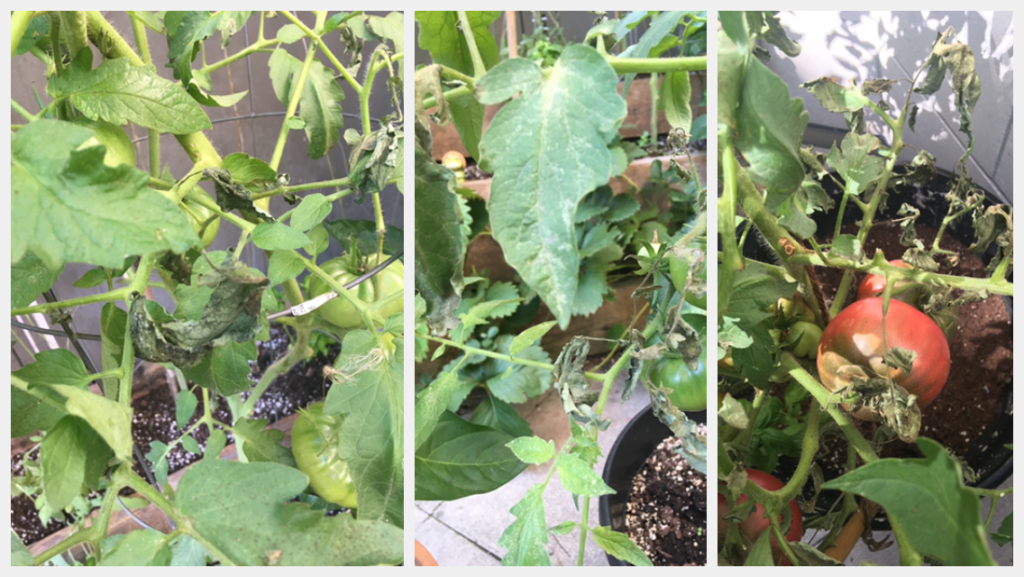
Hi there,
I’m having a sudden and quickly spreading issue with my tomato plants this past week or so that I haven’t been able to identify (and respond to).
I grow tomatoes in pots and in a layered raised bed. A couple (one in a pot, one in bed) started to show blight (I think and not septoria spot, but I’m not an expert) and so I started spraying them, and a couple others that developed the yellowing (two other pots on opposite side from first two and in new soil), with Safer’s sulfur dust (mixed into a liquid). I was doing that about once a week without result, and the blight/yellow spotting was spreading. So I thought I’d try baking soda, as I’d read it works well. I mixed a small spoon of oil, again as I read it helps to keep the mix on the leaves. I sprayed the affected and the not (visibly) affected plants a couple days in a row in the evenings on not scorching hot days. From that point on, every single tomato plant started to look diseased and then dying. Predominantly, they developed black spots. I thought maybe that was the oil, but it then seemed to spread. In the last week my plants have gone from really green and healthy to having entire leaf stems and sections shrivel and dry out. I’m attaching a picture of what it looks like across stages (on some plants it looks like a sandy brown like here, but on most it’s black spots). It hits leaves first (particularly the ones on the fruiting stems), they dry out and shrivel up their little leaf stem and then that proceeds to the entire stems which becomes pencil thin. There is no yellow colouring on these, it’s green to black/brown to dried out entirely to dead. I should note, none of the tomato fruits themselves are affected, nor do the main stems.
Do you know what this is, and can I do anything about it? I stopped spraying them with anything out of fear/confusion. I feel like I somehow spread something when I sprayed (?). I spray my sheers before using them on each plant, so I don’t think it spread that way. The plants/pots were spread out and now I’ve moved them so that no leaves are even touching. Most are in new organic soil (the original blight ones were not so I wasn’t entirely surprised there). I was pruning the affected leaves and stems, but I stopped out of concern of over-pruning/no leaves being left. Should I cut it all off? And if it continues to spread? Your help in identifying and guidance on what to do is greatly appreciated. I can send different pictures if needed. There are still a lot of small green tomatoes growing on these plants and I’m hoping they can be saved.
Also, may I ask – I like to harvest seeds (I did that for the first time last year, many of these plants I grew from seed). Depending on what this is, will it affect the seeds (assuming the tomatoes get to that stage before the plants give out)?
Lastly, if I may, the original blight-affected tomato plants, the yellowing is moving up very quickly and I can’t keep up (barring pruning almost all its leaves.. it’s almost there now). The hardest hit is a roma with dozens of green tomatoes on it still, though without any leaves I wonder how they’ll ripen and taste. Do you advise continuing to prune, or should I stop and maybe spray again? (or give up?).
I know there’s a lot in this message, and I thank you for your time and your advice. I’m hoping I can do something to save these plants as there are potentially still a couple months of growing season left.
Hello, thank you for reaching out to the Toronto Master Gardeners for help with your tomatoes. I am sorry to say you have correctly identified the problem with your tomatoes is Tomato blight. And it does look more like Late blight rather than Septoria blight, but I would have to see closer photographs of leaves to be sure.
Blight (Early and Late blight) are caused by fungal spores which travel in the air and can live on in the soil. By your description I would say that you have done nothing wrong and the black spots and yellowing are just the natural progression of this disease. Tomatoes and Potatoes are extremely susceptible to blight as are other members of the nightshade family. I am including two links that include photos of both early and late blight, this will be helpful in confirming the diagnosis. Unfortunately, there is little that a gardener can do at this stage but remove the plants including the soil surrounding it and send it all to the garbage and not to the compost. Be very careful to remove all of the plant material as you don’t wish this fungus to contaminate anything else in your garden.
As to your question to the fruit, I would refrain from eating any fruit with blemishes, and to be on the safe side I would not keep the seeds. Some strategies to avoid this happening again are to try resistant varieties, avoid planting tomatoes (or potatoes) in the same spot again, and most importantly healthy plants are best able to fight off attacks from these common diseases, so keeping your plants well fed & watered will give them a better chance to fight off any passing spores.
I would also like to include a link to a Master gardener’s advice to another inquiry similar to yours. I wish you better luck with your tomatoes next summer!
https://www.torontomastergardeners.ca/askagardener/late-tomato-blight-2/

